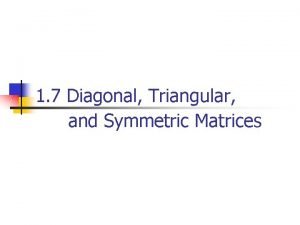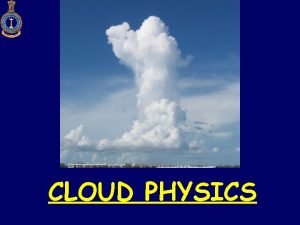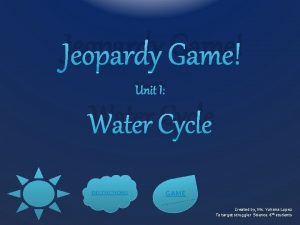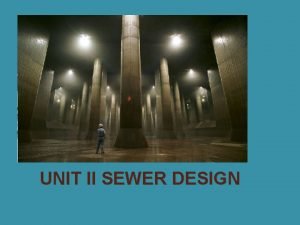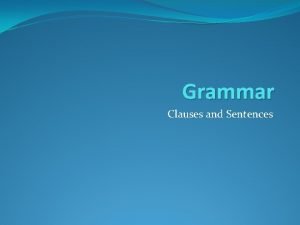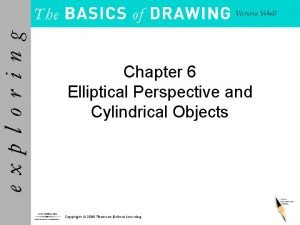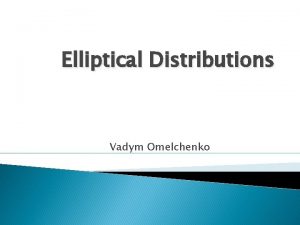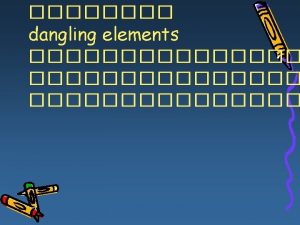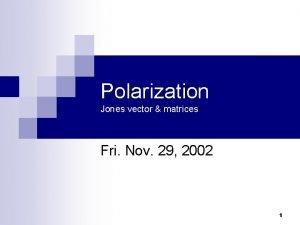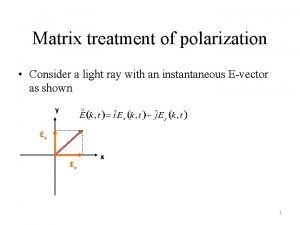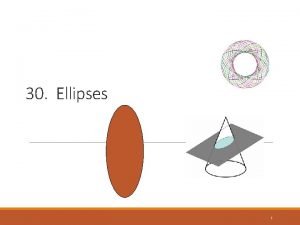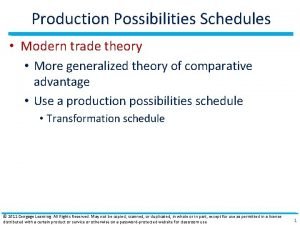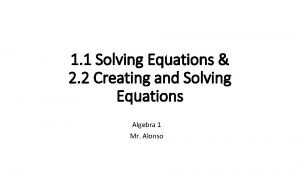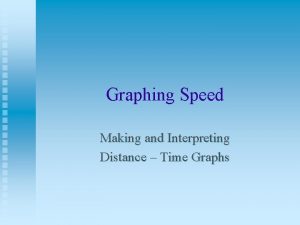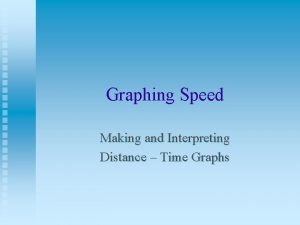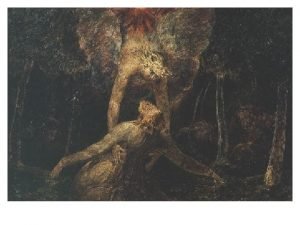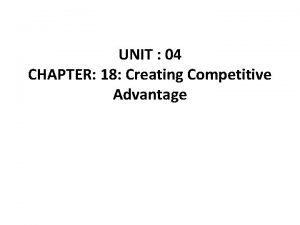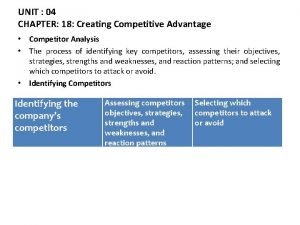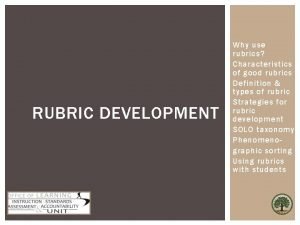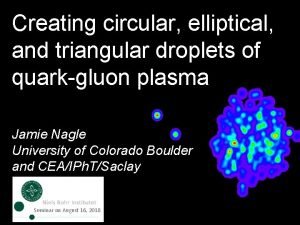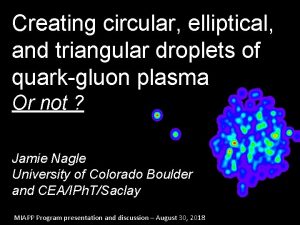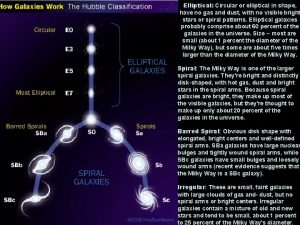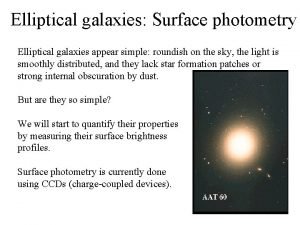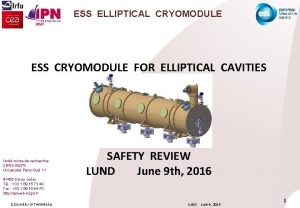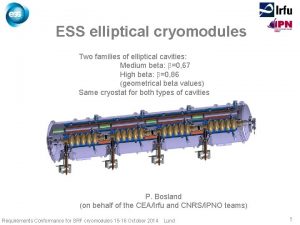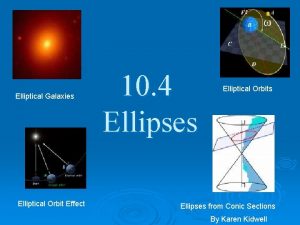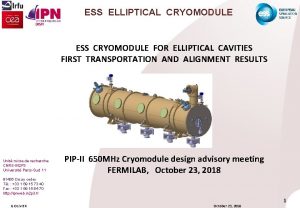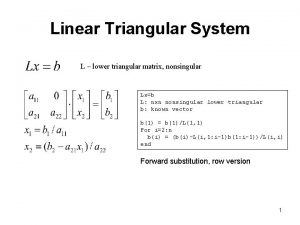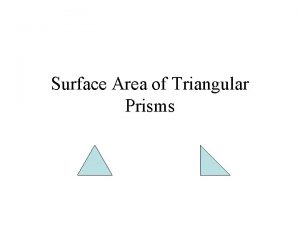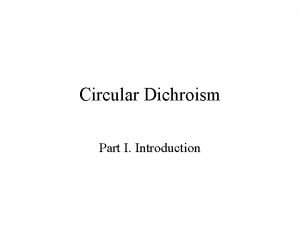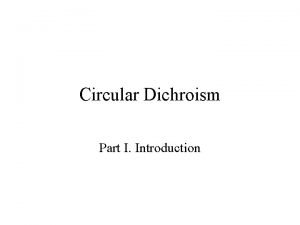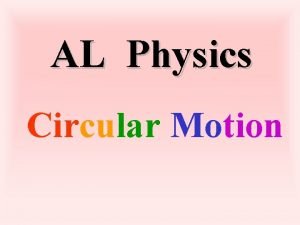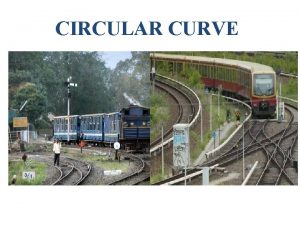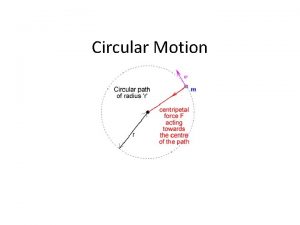Creating circular elliptical and triangular droplets of quarkgluon








![15 days after the PHENIX paper was posted, postdictions appeared Mace et al. [MSTV], 15 days after the PHENIX paper was posted, postdictions appeared Mace et al. [MSTV],](https://slidetodoc.com/presentation_image/9940c1f9ec52e4bf88a0ff44d95a74fc/image-9.jpg)





![Domains just starting Domains not resolved to be resolved Mace et al. [MSTV], https: Domains just starting Domains not resolved to be resolved Mace et al. [MSTV], https:](https://slidetodoc.com/presentation_image/9940c1f9ec52e4bf88a0ff44d95a74fc/image-15.jpg)





































- Slides: 52

Creating circular, elliptical, and triangular droplets of quark-gluon plasma Or not ? Jamie Nagle University of Colorado Boulder and CEA/IPh. T/Saclay MIAPP Program presentation and discussion – August 30, 2018

RHIC Geometry Scan 2

Proton-Neutron Separation Deuteron is a loosely bound system d+Au Sometimes the neutron misses http: //journals. aps. org/prc/abstract/10. 1103/Phys. Rev. C. 90. 034902 3

Experimental Data Follows ordering of eccentricities However, multiplicity also plays a role PHENIX, https: //arxiv. org/abs/1805. 02973 4

Particle Multiplicities https: //arxiv. org/abs/1807. 11928 Midrapidity Values d. Nch/dh ~ 12 p+Au 0 -5% d. Nch/dh ~ 18 d+Au 0 -5% d. Nch/dh ~ 22 3 He+Au 0 -5% Hydrodynamic calculations include the initial geometry differences 5 and match the particle multiplicity for each system

Hydrodynamic Comparison Good agreement with v 2, v 3 (p. T) for all three systems SONIC is a published prediction No tuning of parameters or options for different systems 6

Initial State Explanations 7

More domains that are not aligned, correlation effect is washed out. Nice separation of scales Deuteron size >> Domain Size 8 Exactly the opposite of what is observed in data ! Definitively rule out scenario where initial state correlations dominate via resolved domains of size 1/Qs 8
![15 days after the PHENIX paper was posted postdictions appeared Mace et al MSTV 15 days after the PHENIX paper was posted, postdictions appeared Mace et al. [MSTV],](https://slidetodoc.com/presentation_image/9940c1f9ec52e4bf88a0ff44d95a74fc/image-9.jpg)
15 days after the PHENIX paper was posted, postdictions appeared Mace et al. [MSTV], https: //arxiv. org/abs/1805. 09342 Remarkable results are counterintuitive Code is not publicly available, many details missing so not possible to reproduce results yet There a number of steps — all of which are “essential”

In previous IP-Glasma papers (e. g. ar. Xiv: 1311. 3636) they point out the huge difference between gluons and hadrons. Why is this effect ignored in the MSTV paper? It would be good to compare the MSTV gluon p. T distribution with the published hadron p. T distribution. 10

Essential physics Think of a gluon from the target and its interaction with domains in the projectile… Proton color domains If the k. T < Qs (proj) then the target cannot resolve individual domains and interacts with many of them “coherently” or “simultaneously” Restate this condition as 1/k. T > 1/Qs(proj)

Incoming target gluon with k. T uncertainty principle blurs the gluon with radius r [fm] = hbar/k. T = 0. 2 / k. T[Ge. V] If k. T = 1 Ge. V, r = 0. 2 fm Target gluon wave Projectile (proton) radius ~ 0. 9 fm Proton If Qs = 2 Ge. V, rdomain = 0. 1 fm. Of course this is an absurdly large Qs 2 = 4 Ge. V 2 for the proton x>0. 01 Domains Size ~ 1/Qs Then target gluon sees (Qs/k. T)2 ~ 4 domains at once. 12

Ab initio or non pertinet Many have stated that these color domains effects are calculated ab initio However, saturation physics in the proton at x > 0. 01 challenges the whole picture of the formalism One estimate has Qs, 02 (gluon) = 0. 67 Ge. V 2 for x = 0. 01 at the very center of the proton, and averaged over r = 0. 67 fm the value would be Qs 2 (gluon) = 0. 28 Ge. V 2 13

d+Au case In the overlap region, one sees more “smaller” domains with larger color fields since larger Qs. Neutron Probability of two gluons hitting the overlap region is very small. Proton However, lots of cases where two target gluons see completely uncorrelated regions! 14
![Domains just starting Domains not resolved to be resolved Mace et al MSTV https Domains just starting Domains not resolved to be resolved Mace et al. [MSTV], https:](https://slidetodoc.com/presentation_image/9940c1f9ec52e4bf88a0ff44d95a74fc/image-15.jpg)
Domains just starting Domains not resolved to be resolved Mace et al. [MSTV], https: //arxiv. org/abs/1805. 09342 v 2 (d+Au) > v 2(p+Au) for p. T < 2. 5 Ge. V MSTV: Qs (deut) > Qs (prot) since Nch (0 -5% d+Au) > Nch (0 -5% p+Au) and v 2 scales with Qs(proj) k. T < Qs (proj) does that mean Qs(proj) = 1. 5 -2. 5 Ge. V? Need exact k. T distributions 15

IP-Jazma J. N. and W. A. Zajc https: //arxiv. org/abs/1808. 01276 Open source code: http: //www. phenix. bnl. gov/WWW/publish/nagle/IPJAZMA Just like jazz music, some people will not appreciate it. 16

IP-Jazma Details 1. MC Glauber to obtain nucleon x, y positions in each event 2. Use IP-Sat (impact parameter saturation model) to calculate the Qs 2 distribution on an x, y lattice Note that this is just a uniform Gaussian with s = 0. 32 fm at RHIC Qs 2 is proportional to g 4 m 2 , where m 2 is the number density of color charge per unit transverse area Qs is proportional to g 2 m and is Gaussian with s = 0. 45 fm MSTV (private comm. ) says that “our choice of BG” corresponds to slightly larger s = 0. 56 fm, so I will match that in IP-Jazma 17

3. MSTV includes nucleon-by-nucleon fluctuations in Qs, 0 2 (the amplitude of the IP-Sat Gaussian). Thus, each nucleon is still a perfect Gaussian, just different amplitudes. Implemented with variance 0. 5 on log(Qs 2) – i. e. high side tail. • Non-perturbative on many scales • Not part of the standard CGC framework • Questions regarding the constraints on the functional form 18

Originally proposed by Mc. Lerran (ar. Xiv: 1508. 03292 v 2) to explain high multiplicity tail of LHC p+p Nch distributions. Qs, 02 fluctuates to 5 -6 times average value to explain the high Nch tail. * It is a mistake to assume such matching confirms dynamical fluctuations, instead of from hadronization effects, finite rapidity window, experiment acceptance, etc. 19

+ deuteron gold IP-Jazma Sum all the Qs 2 contributions for each nucleus. Example - nucleons from deuteron as perfect Gaussians from IP-Sat just with different amplitudes from Qs, 0 2 fluctuations. At this point, none of these fluctuations are ab initio. 20 2 All MC Glauber and put-in-by-hand Q fluctuations.

Integrating over Lattice Fluctuations 21

Aside on Spiky IP-Glasma Success of IP-Glasma Au+Au initial conditions often highlighted by these very spikey displays However, IP-Jazma (dense-dense) matches eccentricities e 2 -e 6 Au+Au e 2 e 5 e 3 e 6 e 4 Totally dominated by TA x TB scaling, not color fluctuation spikes. 22

Let the Buyer Beware IP-Glasma https: //arxiv. org/abs/1202. 6646 v 2 IP-Jazma calculation for Au+Au b=9 fm events in dense-dense limit, no Qs, 02 fluctuation, . IP-Jazma d. ET/dy (a. u. ) Note the gluon distribution is not Gaussian (red line) and has a high side skew (G dist. ). Nothing to do with Glasma flux tubes. 23

Dilute-Dense Framework 24

IP-Jazma Dilute-Dense Cyrille Marquet (thanks) sent me this function F. In the limit of large Qs(targ)/m, it scales as log(Qs(targ)/m). Once you hit a thick enough part of the target, you free all the projectile gluons and no more. 25

IP-Jazma Results Right panel shows the density distribution for this event in the dilute-dense limit. There are no sharp spikes in the energy density as often highlighted with IP-Glasma because there are no lattice site color fluctuations – though these are in part artifacts in IP-Glasma. 26

p+Au @ 200 Ge. V Settings: Dilute-Dense, no Qs, 0 2 fluctuations, no running as, rmax = 3. 0 s [leave these last two the same] Distribution of number of gluons (Ng/<Ng>) Once the proton is hitting the mid-region of the target the gluon production reaches a limit i. e. one has freed all the gluons from the projectile proton 27

p+Au @ 200 Ge. V Settings: Dilute-Dense, yes Qs, 0 2 fluctuations In the Monte Carlo, keep track of the Qs, 0 2 thrown for each projectile nucleon. As expected, there is an almost linear increase in gluon number with Qs, 0 2 in the projectile once one is hitting a thick enough part of the nucleus. For 0 -5% high-multiplicity, the value is 2. 2 times higher than average. 28

d+Au @ 200 Ge. V Settings: Dilute-Dense, no Qs, 0 2 fluctuations Some collisions where only proton (or neutron) hits, some collisions where both hit the target) One reaches the limit of freeing gluons from the projectile, 29 proton and neutron in the deuteron.

d+Au @ 200 Ge. V Settings: Dilute-Dense, yes Qs, 0 2 fluctuations Essentially perfect agreement IP-Jazma and MSTV. Common with MSTV we have MCGlauber fluctuations, IP-Sat Qs, 0 2 fluctuations. The additional color fluctuations in MSTV do not appear to be evident Reasonable agreement with STAR up to 0. 5%. Blue line at 5% central. 30

d+Au @ 200 Ge. V Settings: Dilute-Dense, yes Qs, 0 2 fluctuations As expected there is a correlation of higher multiplicity events with larger Qs, 0 2 fluctuations. Smaller than in p+Au because the deuteron nucleons 31 fluctuate separately.

Define an “overlap area” and then calculate <Qs 2> within that area For 0 -5% selection in IP-Jazma, here are the results… p+Au d+Au Area [fm 2] 2. 81 4. 52 d+Au has larger area, but the saturation scale is the same <Qs 2> [Ge. V 2] 0. 56 0. 53 32

In the dilute-dense framework, multiplicity scales with Qs 2 projectile. Thus for 0 -5% centralities, Qs 2 (deuteron) > Qs 2 (proton). [MSTV] We find this MSTV statement is not reproduced. The area is larger, not the saturation scale! The MSTV statement is essential since v 2 is directly related to Qs and 33 this is what they say gives them v 2(d. Au) > v 2(p. Au)

MSTV scaling of Nch with Qs 2(proj) leads them to predict “that v 2, 3(p. T) for high multiplicity events across small systems should be identical for the same Nch. ” Hydrodynamics matches the splitting Turns out this prediction is actually yet another postdiction Existing PHENIX measurement already rules this out! 34

If the v 2(d. Au) > v 2(p. Au) does not come from a larger Qs(proj), where does it come from in the numerical calculation? Notice that v 2(He. Au) ~ v 2(d. Au). MSTV just say this is because some effect saturates (not a real explanation). Of course, be definition of matching the data ordering, it follows eccentricity geometry. Is that a coincidence? 35

MSTV calculation all done in momentum space. Thus, they start by Fourier Transforming the Qs(x, y) spatial distributions into momentum space. That means they start with a kx, ky azimuthal anisotropy that directly reflects the geometry anisotropy. How can we demonstrate that this dominates or is irrelevant to the final resulting v 2? 36

37

Single gluon azimuthal distribution moment (n) for gluons between p 1 and p 2. Not great notation, since most in the field use capital V for a two particle value. Now two particles (one gluon between p. T +/- D/2 and one gluon anywhere – reference) Again, incorrect notation, this is not vn^2, it is c 2 (pt, ref). To get v 2(p. T), one needs to divide this quantity by sqrt[c 2(ref, ref)], though that assumes factorization. 38

Single gluon p. T = kt 1 vector + kt 2 vector Select kt 1 from FT (projectile) and kt 2 from FT (target) Seems odd that Qs scale does not enter here, only the FT (i. e. uncertainty principle) which reflects the spatial distribution and not the amplitude? 39

Summary (So Far) Exciting times for studying small system collectivity Experimental geometry scan at RHIC complete Best agreement via hydrodynamics with QGP stage All theory approaches deserve full scrutiny IP-Jazma new, open source tool for identifying the dominant source of fluctuations in the saturation physics framework Further work to resolve differences in explanations with MSTV result 40

New CGC paper https: //arxiv. org/abs/1808. 09851 But in MSTV (ref 37) they treat target gluons interacting with projectile proton domains! I admit confusion. 41

Extras 42

Trento Comment… ar. Xiv: 1412. 4708 v 2 Trento p=0 is similar to Ncoll scaling (with extra sqrt) with an impact parameter dependence for N-N collisions. Thus, with the right parameters, quite 43 comparable to IP-Glasma, IP-Jazma (dense-dense)

STAR Preliminary results shown at QM 2018 https: //indico. cern. ch/event/656452/contributions/2869833/attachments/1649479/2637419/QM 18 -smallsystem-shengli-10. pdf Due to a small Dh gap, they have a huge non-flow contribution (even at low p. T). That is why they are so sensitive to the non-flow subtraction. PHENIX results checked with Dh gap of 3 units and in systematic uncertainties. 44

Romatschke & Romatschke (https: //arxiv. org/abs/1712. 05815) At RHIC energies, resulting Gaussian in Qs 2 has s = 0. 32 fm. Note that this corresponds to a Gaussian in Qs with s = 0. 45 fm. Of course this depends on your choice of BG, translating into R in the equation below. In dense-dense limit, just sum Qs 2 values for each nucleus. Then energy density proportional to TA 1 A 2 scaling 45

Dilute-Dense? How valid is the dilute-dense limit when we effectively select on events that are larger fluctuations in the projectile saturation scale? 0. 2 0. 5 1. 0 d+Au 0 -5% high mult. events Ratio Qs 2 (proj) / Qs 2(targ) weighted by the gluon contribution in that lattice cell (dilute-dense) Qs 2(proj)/ Qs 2(targ) Naively might have thought ratio ~ 1 / A 1/3 ~ 0. 2, but here we are selecting out 46 fluctuations and cells with highest Qs 2 (projectile).

d+Au @ 200 Ge. V Settings: Dense-Dense, no Qs, 0 2 fluctuations We also obtain a reasonable (slightly worse) description of the data. Modest adjustment of IP-Sat s would allow better tuning. N. B. No correlation between Qs, 02 projectile and gluon multiplicity. 47

d+Au case If the target gluon was HUGE, then all target gluons Neutron would “see” the same domains (all of them) and v 2(d. Au) ~ v 2(p. Au) modulo the small overlap Proton But still need v 2(d. Au) > v 2(p. Au) See later… 48

Parton Transport Explanation In limit of many scatters per parton (> 4 -5), this might be a dual picture to hydrodynamics However, if most partons have zero scatters and others have just one, that seems different AMPT Escape Mechanism paper finds very few scatterings He et al. , https: //arxiv. org/abs/1601. 00878 Recent analytic approach generates significant v 2 with single scatter Kurkela, Wiedemann, Wu ar. Xiv: 1805. 04081 ar. Xiv: 1803. 02072 49

Small system studies with AMPT (publicly available code) Nagle et al. , ar. Xiv: 1707. 02307, Orjuela Koop et al. , ar. Xiv: 1512. 06949, ar. Xiv: 1501. 06880 Bozek, Bzdak, Ma, ar. Xiv: 1503. 03655 AMPT v 2. 25 t 5 relative to true geometry defined by initial nucleons string melting mode, sparton = 0. 75 mb Poor quantitative agreement with data, but rough agreement with system vn ordering

Apples-to-Apples Comparison AMPT fully modeling the Event Plane method in PHENIX Better agreement in 3 He+Au, but much worse in p+Au (non-flow), insufficient statistics for v 3 in the smaller systems (working on it) 51

Thoughts on AMPT and parton transport calculations: Quasiparticle picture only useful if one can correctly identify quasiparticles and their properties (think Condensed Matter Physics) which in AMPT are nearly massless < 20 Me. V quarks, no gluons Also, one then needs to describe the “cornucopia” of other observables. For example, AMPT achieves the v 2 PID dependence roughly via hadron rescattering. Very important for the field to have multiple tools (beyond AMPT) to assess how this picture works… 52
 It is a circular or elliptical anticlinal structure
It is a circular or elliptical anticlinal structure Diagonal matrix properties
Diagonal matrix properties What are cloud droplets
What are cloud droplets Which of the three blood droplets shown
Which of the three blood droplets shown Droplets
Droplets Droplets
Droplets Brain droplets
Brain droplets Water cycle jeopardy
Water cycle jeopardy What are the five principles of hair design
What are the five principles of hair design Galaxie s
Galaxie s Parabolic sewer
Parabolic sewer Verb acting as an adjective
Verb acting as an adjective Elliptical clause examples
Elliptical clause examples Facts about elliptical galaxies
Facts about elliptical galaxies What is cartesian form
What is cartesian form Drawing cylindrical objects
Drawing cylindrical objects Elliptical adverb clause examples
Elliptical adverb clause examples Elliptical clause
Elliptical clause The art of styling sentences answer key
The art of styling sentences answer key Blood spatter activity
Blood spatter activity Compound sentence with explanatory statement
Compound sentence with explanatory statement Wound description with pictures
Wound description with pictures Elliptical examples
Elliptical examples What is a dangling participle
What is a dangling participle Jones vector elliptical polarization
Jones vector elliptical polarization Jones vector elliptical polarization
Jones vector elliptical polarization Type of galaxy
Type of galaxy A semi elliptical archway
A semi elliptical archway Describing visual data
Describing visual data Creating production possibilities schedules and curves
Creating production possibilities schedules and curves Principles of marketing chapter 1
Principles of marketing chapter 1 Porters 3 generic strategy
Porters 3 generic strategy Creating customer value satisfaction and loyalty
Creating customer value satisfaction and loyalty Creating customer value satisfaction and loyalty
Creating customer value satisfaction and loyalty By listening to my inner defender voice i can be sure that
By listening to my inner defender voice i can be sure that Creating and starting the venture
Creating and starting the venture Creating vision and strategic direction
Creating vision and strategic direction Mari carlos and amanda collect stamps
Mari carlos and amanda collect stamps Creating and capturing customer value
Creating and capturing customer value Marketing concept
Marketing concept Creating customer value satisfaction and loyalty
Creating customer value satisfaction and loyalty Excel module 1: creating a worksheet and a chart
Excel module 1: creating a worksheet and a chart An expanded model of the marketing process
An expanded model of the marketing process Creating and interpreting distance time graph
Creating and interpreting distance time graph Graphing speed
Graphing speed The american people creating a nation and a society
The american people creating a nation and a society Creating and capturing value
Creating and capturing value Elohim creating adam by william blake
Elohim creating adam by william blake Value creation strategy
Value creation strategy Chapter 18 creating competitive advantage
Chapter 18 creating competitive advantage Creating a dinosaur sculpture
Creating a dinosaur sculpture Features of assessment rubrics
Features of assessment rubrics Yas spread to benchmark
Yas spread to benchmark

